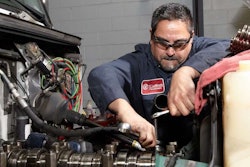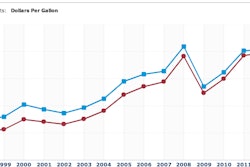There was a lot of talk about tires at the TMC Spring Meeting in Nashville this week. It seems that every fleet attending does something different in terms of pressure and maintenance — and that none of them are actually confident they have a good tire plan in place.
In fact, noted tire expert Al Cohn, with Pressure Systems International, noted some interesting tire maintenance facts that came to light in a recent survey of TMC members. A few pertinent points:
* The Average TMC Fleet experiences/deals with 93 tire-rellated roadside sdervice calls each and every month.
* Crunching the numbers, that works out to one tire related service call for every 74,000 miles those fleets run.
* Most fleets do not benchmark against similar fleets.
* And the survey found that tire pressure check frequencies are all across the board: Some fleets expect the drivers to do it. Some fleets do it once a day. Others once a week. Others when a tire looks low.
Unfortunately, as Kirk Altrichter, Vice President, maintenance, Crete Carrier, good tire care is tedious. Somebody’s got to go out on the yard, bend down, put a gauge on a tire and see what the actual pressure is. Whether it’s a driver or a tire tech, that’s a tough job that gets old fast.
To make things even more complicated, even if you do have a good tire-check program in place, you still may be be getting consistent performance from your tires because most tire gauges are not reliable.
Cohn has done studies showing that even high-quality tire gauges can be off by 3 to 5 psi right out of the box; and the error factor increases every time a gauge is dropped or simply used over and over again. Don’t be surprised if you spot check gauges and discover that they’re off by 15 pounds or more.
What to do? The answer is — as always — is to spend more money and buy high quality calibrated tire gauges. The good news is that these gauges aren’t prohibitively expense: You can expect to pay around $20 to $25 for one. But you do need to invest in a more expensive master gauge to check their pressure against. This needs to be done fairly often — In fact, making it a Standard Operating Procedure every single morning isn’t a bad idea. Once you’ve checked the pressure, an adjustment screw on the gauge will allow you to quickly to get it set right and inure consistent pressure readings.
Additionally, there seems to be a lot of confusion out there on correct pressure settings for a fleet. Run a tire too low, and you’re going to accelerate wear on the outer edges. Run a tire too high, and you’re going to accelerate wear in the middle.
Most fleets, it seem, try one pressure for a while and see what happens. Then, they try another pressure to see what happens. And so on and so on.
Peggy Fisher, with Tire Stamp, says the only way to accurately determine your tire pressure is to measure your loaded truck – both by individual axle weights and gross cargo weight — and then consulate your tire OEM’s load calibration charts which will tell you the correct pressure to use with those loads.
Having a good tire plan in place is, admittedly tedious. But with tires consistently falling in the Top 3 annual expenses for fleets, it’s a plan your fleet cannot afford to phone in.











